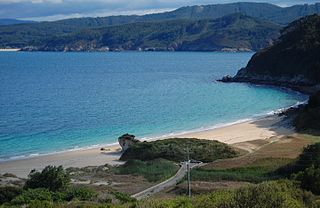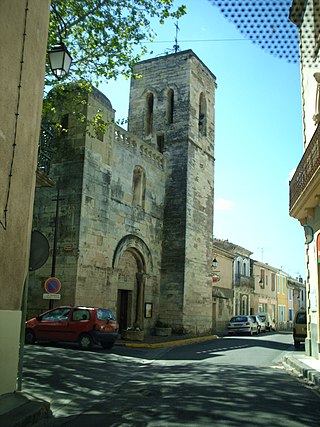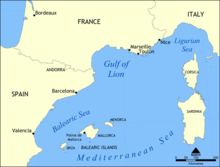
Occitan, also known as lenga d'òc by its native speakers, sometimes also referred to as Provençal, is a Romance language spoken in Southern France, Monaco, Italy's Occitan Valleys, as well as Spain's Val d'Aran in Catalonia; collectively, these regions are sometimes referred to as Occitania. It is also spoken in Calabria in a linguistic enclave of Cosenza area. Some include Catalan in Occitan, as the distance between this language and some Occitan dialects is similar to the distance between different Occitan dialects. Catalan was considered a dialect of Occitan until the end of the 19th century and still today remains its closest relative.

Provence is a geographical region and historical province of southeastern France, which extends from the left bank of the lower Rhône to the west to the Italian border to the east; it is bordered by the Mediterranean Sea to the south. It largely corresponds with the modern administrative region of Provence-Alpes-Côte d'Azur and includes the departments of Var, Bouches-du-Rhône, Alpes-de-Haute-Provence, as well as parts of Alpes-Maritimes and Vaucluse. The largest city of the region and its modern-day capital is Marseille.

The Bay of Biscay is a gulf of the northeast Atlantic Ocean located south of the Celtic Sea. It lies along the western coast of France from Point Penmarc'h to the Spanish border, and along the northern coast of Spain, extending westward to Cape Ortegal. The southern area of the Bay of Biscay that washes over the northern coast of Spain is known locally as the Cantabrian Sea.

Jean-Baptiste le Rond d'Alembert was a French mathematician, mechanician, physicist, philosopher, and music theorist. Until 1759 he was, together with Denis Diderot, a co-editor of the Encyclopédie. D'Alembert's formula for obtaining solutions to the wave equation is named after him. The wave equation is sometimes referred to as d'Alembert's equation, and the fundamental theorem of algebra is named after d'Alembert in French.

Hérault is a department of the region of Occitania, Southern France. Named after the Hérault River, its prefecture is Montpellier. It had a population of 1,175,623 in 2019.

Thomas Corneille was a French lexicographer and dramatist.

The French Riviera, known in French as the Côte d'Azur, is the Mediterranean coastline of the southeast corner of France. There is no official boundary, but it is considered to be the coastal area of the Alpes-Maritimes department, extending from the rock formation Massif de l'Esterel to Menton, at the France–Italy border, although some other sources place the western boundary further west around Saint-Tropez or even Toulon. The coast is entirely within the Alpes-Maritimes, a department within Provence-Alpes-Côte d'Azur region of France. The Principality of Monaco is a semi-enclave within the region, surrounded on three sides by France and fronting the Mediterranean. The French Riviera contains the seaside resorts of Cap-d'Ail, Beaulieu-sur-Mer, Saint-Jean-Cap-Ferrat, Villefranche-sur-Mer, Antibes, Juan-les-Pins, Cannes, and Theoule-sur-Mer.

Provençal is a variety of Occitan, spoken by people in Provence and parts of Drôme and Gard. The term Provençal used to refer to the entire Occitan language, but more recently it has referred only to the variety of Occitan spoken in Provence. However, it can still be found being used to refer to Occitan as a whole, e.g. Merriam-Webster states that it can be used to refer to general Occitan, though this is going out of use.

The mistral is a strong, cold, northwesterly wind that blows from southern France into the Gulf of Lion in the northern Mediterranean. It produces sustained winds averaging 31 miles an hour, sometimes reaching 60 miles an hour. It can last for several days. Periods of the wind exceeding 30 km/h for more than sixty-five hours have been reported.t is most common in the winter and spring, and strongest in the transition between the two seasons.

Occitania is the historical region in Southern Europe where the Occitan language was historically spoken and where it is sometimes used as a second language. This cultural area roughly encompasses much of the southern third of France as well as part of Spain, Monaco, and parts of Italy.

Jacques Nicolas Bellin was a French hydrographer, geographer, and member of the French intellectual group called the philosophes.

Mistral (L9013) is an amphibious assault ship, a type of helicopter carrier, of the French Navy. She is the fourth vessel to bear the name, and is the lead ship of the Mistral-class amphibious assault ships.

Roquemaure is a small town and commune in the Gard department of southern France. The town lies 12 kilometres north of Avignon on the right bank of the Rhône. In 2017 the commune had a population of 5,481.

Tramontane is a classical name for a northern wind. The exact form of the name and precise direction varies from country to country. The word came to English from Italian tramontana, which developed from Latin trānsmontānus, "beyond/across the mountains", referring to the Alps in the North of Italy. The word has other non-wind-related senses: it can refer to anything that comes from, or anyone who lives on, the other side of mountains, or even more generally, anything seen as foreign, strange, or even barbarous.

Antoine Augustin Calmet, O.S.B., a French Benedictine monk, was born at Ménil-la-Horgne, then in the Duchy of Bar, part of the Holy Roman Empire.

Le Cailar is a commune in the Gard department in southern France. It is located at the confluence of the River Vistre and the River Rhôny. It was an important port during the Iron Age at a time when lagoons connected to the Mediterranean Sea covered the adjoining low-lying land.

Pierre Tarin (1725–1761) was a French doctor, writer, and translator, born in Courtenay. He is best known for his contributions to Encyclopédie by Diderot and D'Alembert.

Occitania is the southernmost administrative region of metropolitan France excluding Corsica, created on 1 January 2016 from the former regions of Languedoc-Roussillon and Midi-Pyrénées. The Council of State approved Occitania as the new name of the region on 28 September 2016, coming into effect on 30 September 2016.

Émile Ripert (1882–1948) was a French academic, poet, novelist and playwright. He served as the inaugural Chair of Provençal Language and Literature at Aix-Marseille University. He was the author of three novels, four poetry collections, three plays and five non-fiction books about Provençal culture.
Jacques Montet was an 18th-century French pharmacist, chemist and encyclopediste.


















